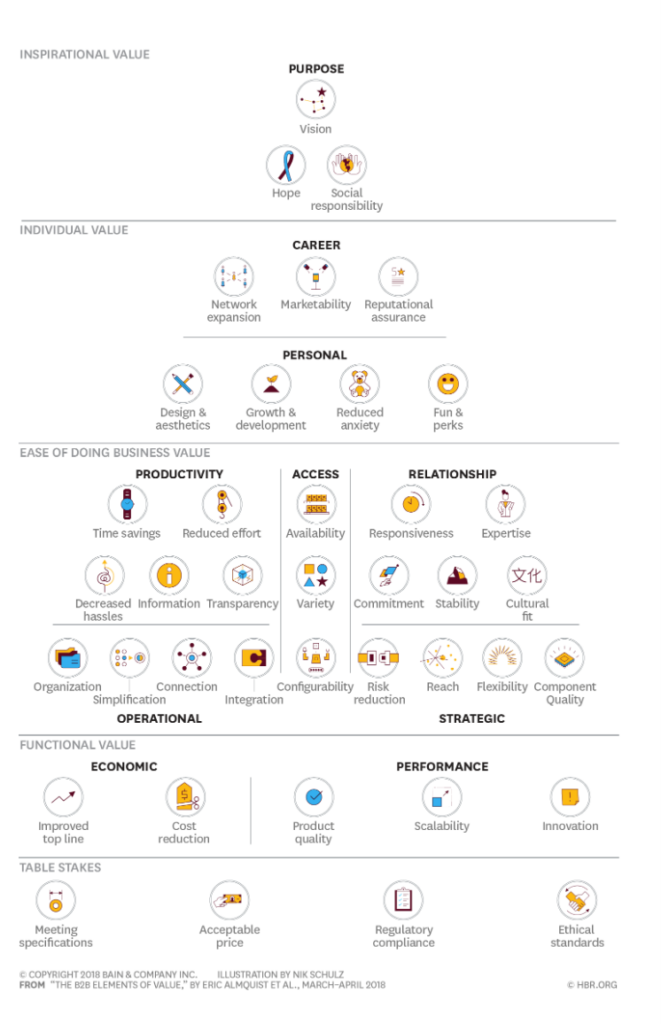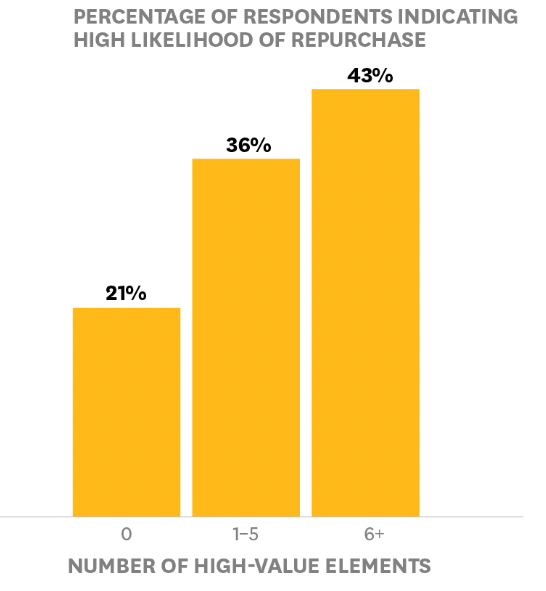“There’s a very simple skeleton key to customer research: the question, ‘Why?’ You ask your sales force, ‘Why did they buy it? Why are they thinking that?’ It’s actually not that hard. It’s just not convenient.” — Jamie Cleghorn, Senior Partner, Bain & Company
Why do so many B2B companies seem to be unable to connect their vision with what the buyer wants? It’s a problem we see all too often at The Storied Future, which is why we invited Bain & Company’s Jamie Cleghorn and Rishi Dave onto The Storied Future Podcast to discuss the question. Jamie is one of the authors of a 2018 article in Harvard Business Review titled “The B2B Elements of Value: How to measure—and deliver—what business customers want.” In the piece, Jamie (along with fellow authors Eric Almquist and Lori Sherer) argue that the factors that drive business-to-business decisions are every bit as emotion-driven as those that drive consumer decisions. And no matter how diverse B2B buyers’ needs and preferences may seem, there are in fact universal building blocks of value that companies can use to connect with customers and improve performance. They write, “As B2B offerings become ever more commoditized, the subjective, sometimes quite personal concerns that business customers bring to the purchase process are increasingly important.” Bain analyzed three decades’ worth of quantitative and qualitative customer studies the company had done to identify 40 fundamental B2B Elements of Value. When mapped against Maslow’s hierarchy of needs, the elements fall into five categories: table stakes, functional, ease of doing business, individual, and inspirational. Many of those elements are familiar buzzwords in B2B marketing campaigns: “acceptable price, regulatory compliance, product quality.” Others might seem more aspirational: “hope, vision, social responsibility.” All the elements—when done well and communicated with buyers—can become powerful differentiators. The value of values Bain didn’t stop with identifying elements that drive purchasing decisions. They began surveying over 2,300 corporate decision makers in the IT infrastructure and commercial insurance industries to measure their perceptions of how companies performed on the various elements. Their theory was that they’d see an uptick in performance with companies that ranked high. The reality was much more surprising. Buyers reported they were twice as likely to repurchase from companies that scored high in 6 or more elements than companies with no high scores. Using the B2B Elements of Value It’s not just a matter of picking a handful of values off the chart, though. Those values need to flow from—and to—the customer. They need to be buyer-pulled, rather than company-pushed. In their joint interview for The Storied Future podcast, Jamie and Rishi noted that classic B2B marketing focuses on the bottom of the pyramid: speed, price, time saving, risk reduction, and other functional aspects. Those marketing at the top of the pyramid—focusing on inspirational value of their brand or product—can sometimes come across as fake, or worse, as performative. Jamie told us that one reason companies have difficulty navigating that challenge is that the messaging isn’t aligned throughout the organization. They either create messaging that’s so adherent to the top of the pyramid that it works in buzzwords but doesn’t connect with buyers, or they ignore the top entirely. “A lot of it comes back to just defining the customer that we’re going for,” Jamie said. “What’s an outcome we’re striving towards? And how do we give people a map from that 100,000 foot down to that 10,000 foot so that our brand marketers and our product marketers actually have a coherent through line?” How can you make sure your brand isn’t just competing on function, without being so aspirational that buyers roll their eyes? Values flow from the customer At The Storied Future, we begin every strategic narrative initiative with an interview process where we talk to customers, and the people who influence them, to mine for Atomic Stories—those moments of discovery, frustration, delight, and curiosity—that illustrate exactly how a company’s value comes to life for the buyer. Bain’s process also begins with listening to the customer, said Rishi, who’s held CMO roles at a number of companies before coming to Bain. “Listening to customers?” he asked. “I don’t think that companies do that enough.” Conversations with the customer—both through interviews, and through listening to what the sales team is experiencing—become the basis for any messaging Rishi and his team create. But they don’t stop there. They also spend time intuitively testing the messaging to see if it resonates, then they make sure the company is aligned around the message from top to bottom. As CMO of Dun & Bradstreet, Rishi led the 175-year-old company’s rebranding efforts to modernize the company. In making sure that everyone was using messaging consistently across the whole hierarchy, he saw excitement—and engagement numbers—rise in the sales team and other employees. “[A]s we launched the brand, when customers actually came to them, for the first-time customers knew what we did.” Messaging that’s truly aligned The key lesson of the Bain B2B Elements of Value is one that many B2B brands forget: Bain asked the buyers to rank brands on how well they aligned with values, not the brands themselves. Yes, your company can define which values you want to focus on. Yes, your company can broadcast those values out in your marketing campaigns. But unless those values flow backwards from the customer to the brand, they’re not likely to resonate. Want to learn how to truly align your messaging with what your buyers want? Listen to the podcast episode with Jamie Cleghorn and Rishi Dave to hear our conversation around that, and get even more insights.- July 20, 2024
- Chris Hare
Narrative on the Fly: Navigating Midlife Transitions
A bespoke fly fishing, storytelling, and coaching experience for CEOs, executives, and midlife business leaders





